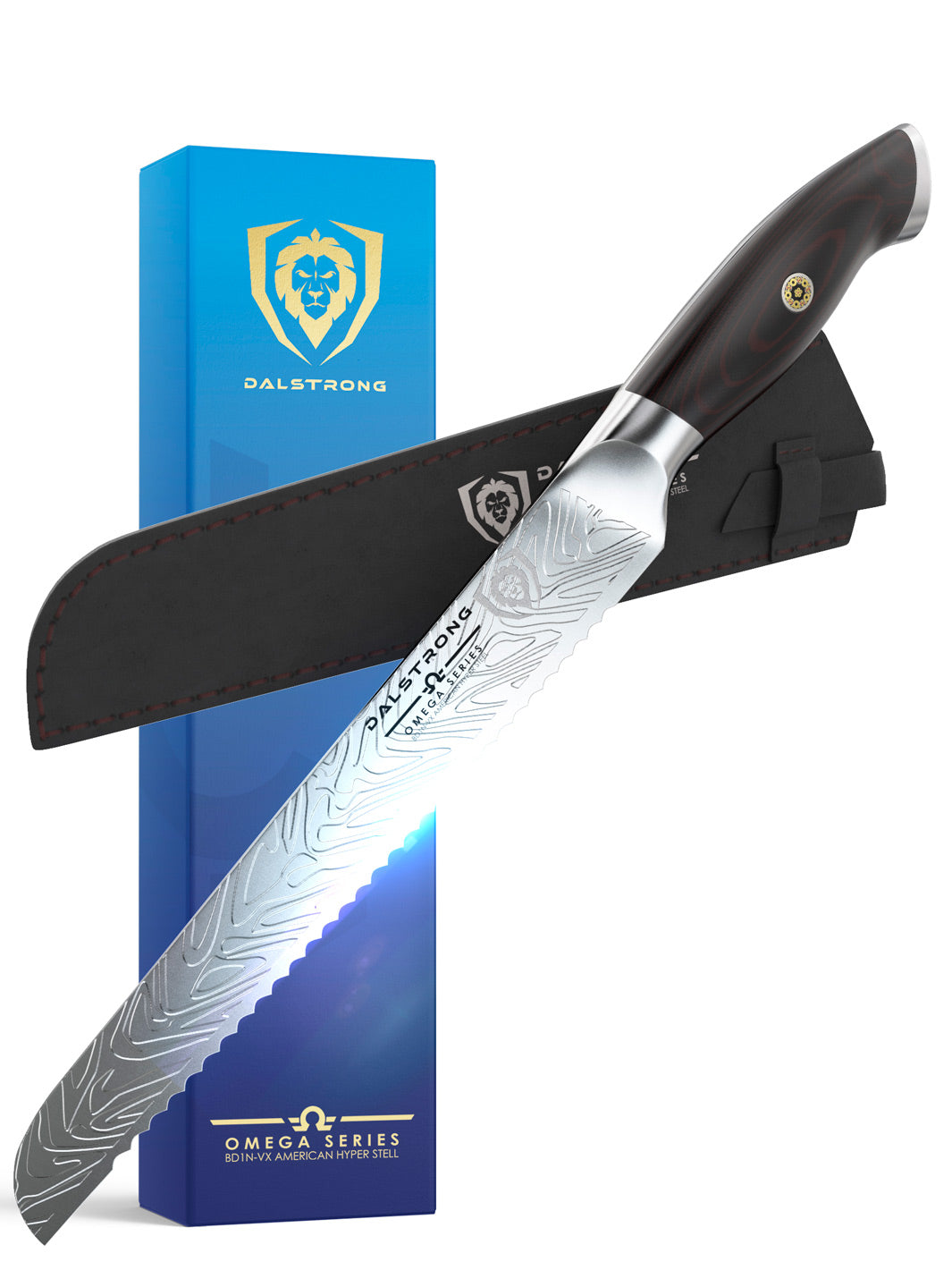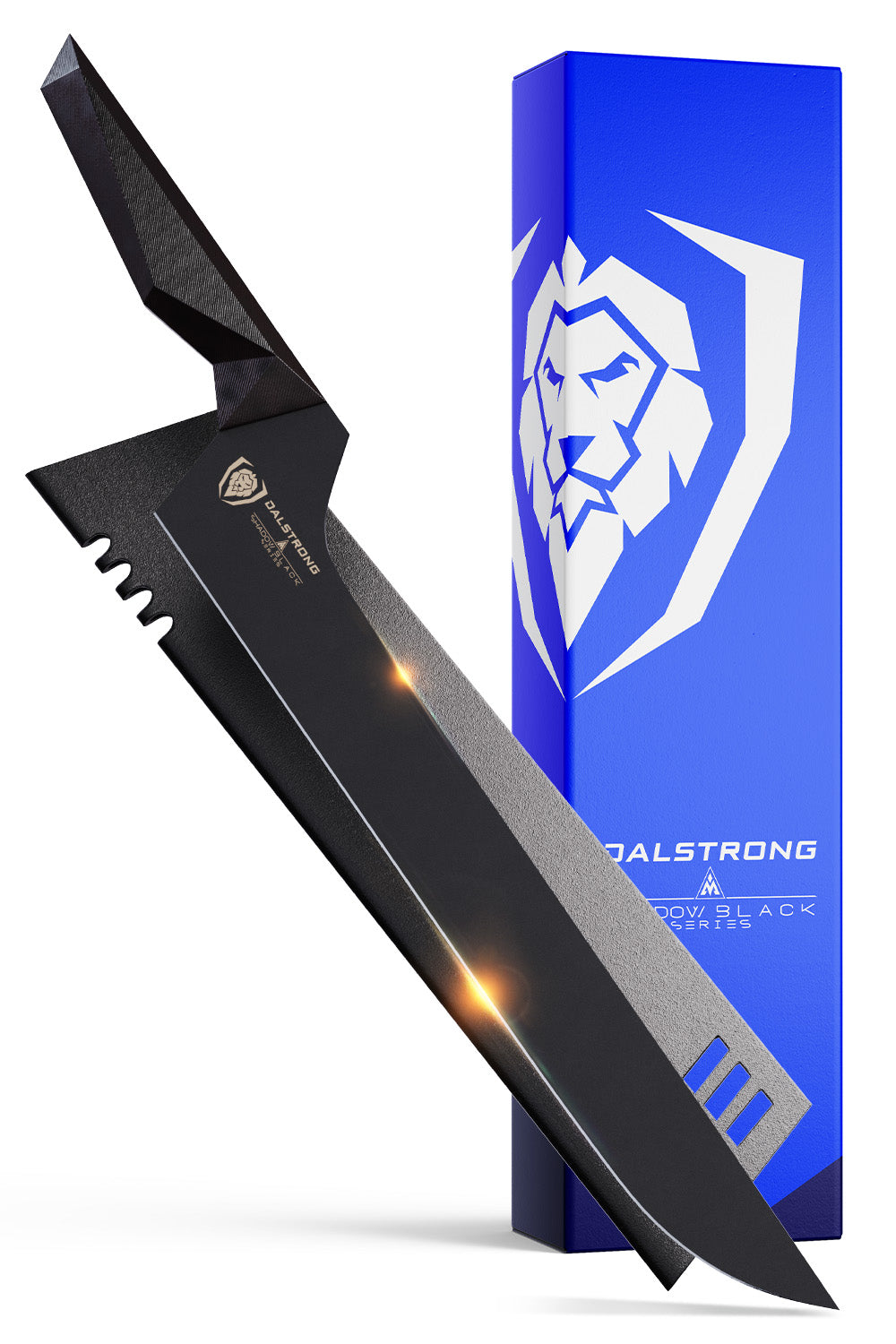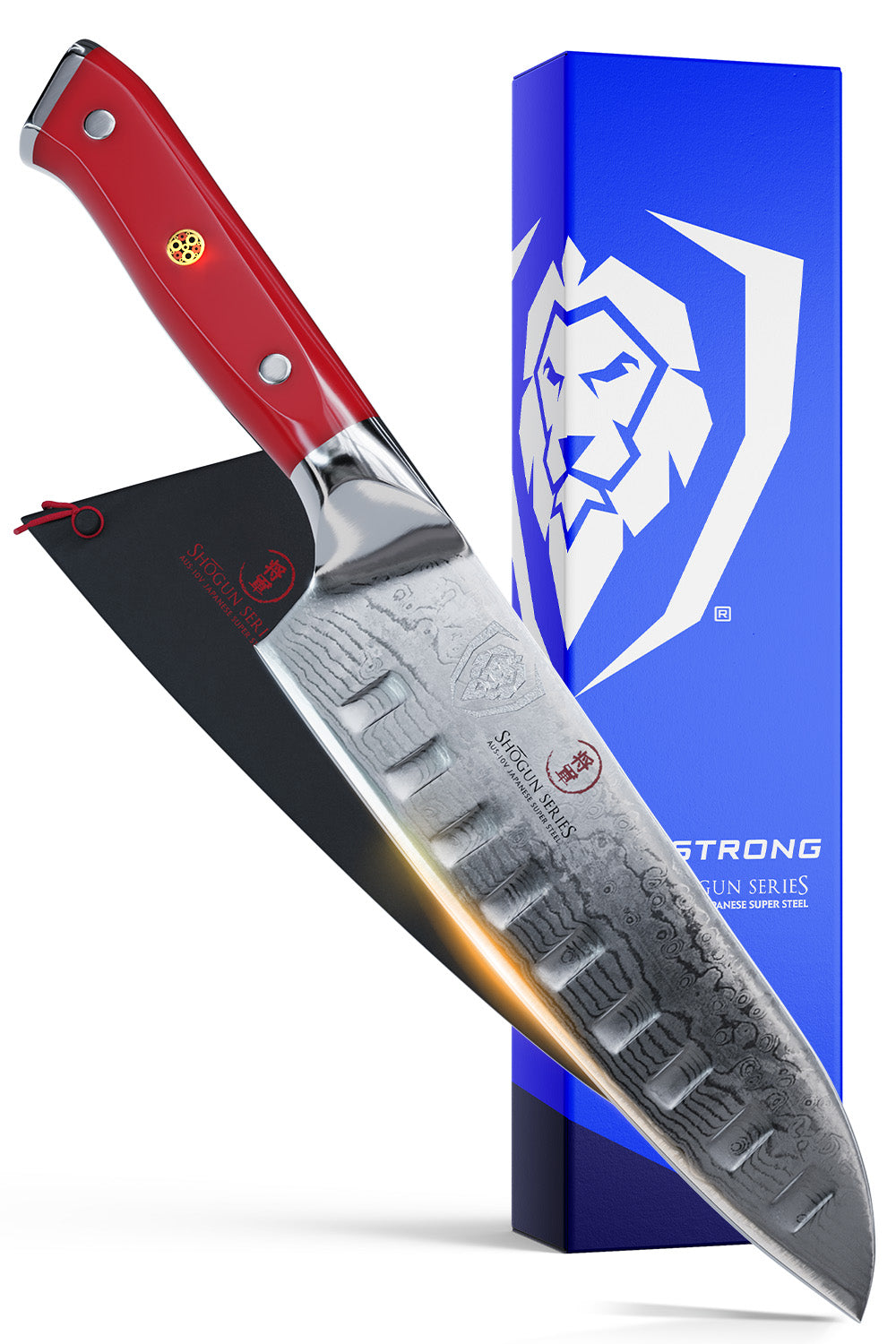Throughout history, the Viking civilization has captivated the imaginations of scholars, enthusiasts, and adventurers alike. From their awe-inspiring voyages to their renowned craftsmanship, the Vikings left an indelible mark on human history. Among the countless artifacts that bear testament to their ingenuity and mastery, the Viking knife stands as a striking symbol of their legacy. It is proof of the artistry and ingenuity of Norse artisans who utilized iron and fire to craft a tool that was as all-around as it was deadly.
In this article, we delve into the captivating evolution of the Viking knife, tracing its origins, development, and enduring impact. From its early utilitarian roots as a tool for daily survival to its transformation into a formidable weapon of war, the Viking knife underwent a remarkable metamorphosis over the centuries.
1. What Is A Viking Knife
 Chef's Knife 8" Valhalla Series Dalstrong
Chef's Knife 8" Valhalla Series Dalstrong
A Viking knife refers to a type of forged knife that was used by the Vikings, who were seafaring warriors and traders from the Scandinavian region during the Viking Age (approximately 793 to 1066 AD). These knives were an essential tool for the Vikings and served various purposes such as cutting, carving, and sometimes as a weapon in close combat.
Viking seax knives typically had a single-edged blade, which was usually around 3 to 8 inches (7.5 to 20 cm) in length. The blade was often made of iron or steel and had a distinctive shape with a wide, curved cutting edge and a pointed tip. The handle of the forged knife was typically made of materials like wood, bone, antler, or horn, and sometimes decorated with intricate carvings or inlays. These knives were versatile tools that were used for everyday tasks such as food preparation, woodworking, and general utility purposes. They were also carried as personal viking weapons for self-defense or as backup viking weapons in addition to swords and vikings axes.
Viking seax knives are often associated with the Norse mythology and culture, and are popular among enthusiasts, collectors, and reenactors interested in Viking history and weaponry. Today, replicas of Viking knives are available, crafted with similar materials and designs to resemble the blades used by the Vikings.
2. Evolution Of Viking Knife
 Chef & Cleaver Hybrid Knife 8" The Crixus Valhalla Series Dalstrong
Chef & Cleaver Hybrid Knife 8" The Crixus Valhalla Series Dalstrong
The evolution of Viking knives can be traced through the various stages of the Viking Age and the influences of different cultures and technological advancements during that time. Here's a general overview of the evolution of Viking knives:
Early Viking Age (8th-9th century)
During the early Viking Age, Viking seax knives were typically simple and utilitarian in design. They had straight or slightly curved blades with single edges, often made of iron. The handles were commonly made of organic materials like wood, bone, or antler. These knives were practical tools used for various tasks such as cutting, carving, and eating.
Middle Viking Age (10th century)
As the Viking Age progressed, Viking dagger knives during the middle ages of the Viking age started to exhibit more decorative elements and regional variations. The blades became longer and acquired a distinctive shape with a wide, curved cutting edge and a pointed tip. The handles continued to be made from organic materials but began to feature more intricate carvings and inlays. Knives during this period were still primarily utilitarian tools, but they also started to serve as symbols of status and wealth.
Late Viking Age (11th century)
Towards the end of the Viking Age, Viking knives underwent further developments in design and craftsmanship. The blades became more refined, often exhibiting complex pattern-welding techniques that created visually appealing patterns on the steel blade. The handles started to incorporate more elaborate decorations, such as metal fittings and engravings. Knives during this period became more ornate and began to play a significant role as status symbols and personal accessories.
Influences from Other Cultures
Throughout the Viking Age, the Vikings came into contact with various cultures through their extensive trading and raiding activities. This exposure to different civilizations influenced the design and construction of Viking knives. For example, the Vikings adopted elements from Anglo-Saxon, Frankish, and Celtic cultures, incorporating their styles and techniques into their own knife-making practices.
It's important to note that Viking knives varied in design and style across different regions and time periods. There were no strict rules governing their appearance, and variations can be observed based on regional preferences, social status, and the available resources and craftsmanship of the time. Surviving examples of Viking knives discovered through archaeological finds provide valuable insights into their evolution and the skills of the Viking craftsmen.
3. Modern Viking Knives
 Slicing & Carving Knife 12" Valhalla Series Dalstrong
Slicing & Carving Knife 12" Valhalla Series Dalstrong
Modern Viking knives are contemporary versions of the historical Viking knives, designed and crafted with inspiration from the Viking Age. These knives are often created by modern artisans, blacksmiths, and medieval knife makers who specialize in historical and traditional blade crafting techniques.
Modern Viking knives typically strive to capture the essence of the historical Viking knives while incorporating some modern improvements in materials and craftsmanship. Here are some characteristics commonly found in modern Viking knives:
Traditional Viking Knife Design
Modern Viking knives feature the iconic shape and characteristics of Viking blades, including the wide, curved cutting edge and a pointed tip. The blades may be made of high-quality carbon steel or stainless steel, depending on the intended use and preference of the maker.High-Quality Materials
While traditional Viking knives were often made from iron, modern versions may use high-quality steels such as Damascus steel or pattern-welded steel to enhance the blade's strength, durability, and visual appeal. Handles are frequently made from genuine materials like wood, bone, or antler, but modern variants may also incorporate synthetic materials for added stability and aesthetics.Craftsmanship and Detailing
Modern Viking knives often exhibit meticulous craftsmanship, with attention to detail in blade grinding, shaping, and finishing. Some makers use traditional techniques like forging, heat treatment, and hand-polishing to replicate the authenticity of historical Viking knives. Decorative elements such as engravings, filigree work, and inlays may be added to enhance the aesthetic appeal.Functionality
While modern Viking knives maintain the historical aesthetic, they are also designed to be functional tools. The blades are typically sharp, durable, and suitable for a variety of tasks like cutting, carving, and general utility.Customization
Many modern Viking knife makers offer customization options, allowing customers to choose specific blade lengths, handle materials, and other details to create a personalized forged knife that suits their preferences and needs.It's worth noting that modern Viking knives are not limited to strict historical accuracy but often represent interpretations and artistic expressions of Viking-era blades. They are popular among forged knife enthusiasts, collectors, historical reenactors, and those with an interest in Viking culture and heritage.
4. Dalstrong Valhalla Series
The Dalstrong Valhalla Knife Series is the embodiment of a modern Viking knife that fuses ancient traditions with contemporary innovation. Just as the legendary Vikings were revered for their mastery of blades, this extraordinary collection pays homage to their indomitable spirit. Crafted with meticulous attention to detail, these knives boast exceptional strength, precision, and uncompromising performance. With blades forged from high-carbon stainless steel and handles designed for both style and ergonomic comfort, the Valhalla series empowers chefs to conquer any culinary voyage with ease and finesse.
Whether you're a professional chef or an aspiring home cook, these knives evoke the Viking warrior within, allowing you to wield the power of the past while embracing the demands of the present.
Let's check out some must-have knives from the Dalstrong Valhalla Series that you shouldn't miss.
1. Chef's Knife 8" Valhalla Series Dalstrong
The Valhalla Chef Knife personifies the vicious spirit of the Vikings, allowing you to conquer any culinary battlefront with precision and grace. With its matchless ergonomic design, sharpness, and remarkable aesthetics, this mighty instrument of culinary mastery will carry you to a realm where every dice, slice, and chop is a thrilling triumph.
PROS:
- Attractive sandblasted finish.
- Easy to clean and low maintenance.
- Hand forged sharpened to 8-12° each side.
CONS:
- Some might not be a fan of the Viking look.
- This might be a little lighter than you’re expecting at first.
2. Chef & Cleaver Hybrid Knife 8" The Crixus Valhalla Series Dalstrong
The Dalstrong Crixus Valhalla Series Chef and Cleaver Knife is a formidable fusion of power and precision. It is hand-forged to conquer any culinary challenge with relentless efficiency. Inspired by the mythical gladiator Crixus and the timeless spirit of the Vikings, this knife is a testament to the pursuit of culinary greatness.
PROS:
- Tapered design for flexibility and hardness.
- Stain-resistant and wear-resistant
- 8” Precision forged Viking knife, featuring an ultra-sharp blade.
CONS:
- This is a formidable tool. A bit heavier than you’re used to.
- If you’re not a home cook or veteran chef, the build of this cleaver and butcher knife could be intimidating for you.
3. Boning Knife 6" Valhalla Series Dalstrong
The Boning Knife 6" from the Valhalla Series by Dalstrong is a culinary tool hand forged for the delicate and precise task of deboning poultry, meats, and fish. With its razor-sharp and narrow blade, this boning knife easily glides along joints, bones, and connective tissues, allowing for clean and precise cuts.
PROS:
- A truly unique-looking and beautiful knife, comes with a superb leather sheath.
- An ultra-sharp, wear-resistant, and precision-forged Viking knife.
- Hot and cold resistant for long-term durability.
CONS:
- This knife's trademark is clearly an eye-catching design. if you’re looking for something a bit more downplay, you’d be better served by some of the other Dalstrong knife series.
4. Slicing & Carving Knife 12" Valhalla Series Dalstrong
The 12-inch blade of the Slicing & Carving Knife is carefully forged from high-carbon stainless steel. Famous for its exceptional durability, strength, and resistance to corrosion and stains. Its extended length allows for long, constant strokes, securing effortless and smooth slicing, while the small width minimizes friction, lowering the risk of shredding or tearing delicate cuts of meat.
PROS:
- 12” Precision forged, wear-resistant, and ultra-sharp.
- Can hold out against erosion from acids, chemicals, or harsh conditions.
- Stabilized wood handle and Premium quality resin.
CONS:
- This knife may not be in everyone’s budget.
- Some go for the military-grade handles.
5. Nakiri Knife 7" Valhalla Series Dalstrong
This knife is hand forged and designed with the principles of both function and form. The Nakiri Knife features a fitting handle inspired by Viking legacy. The handle allows a comfortable and secure grip, allowing for accurate control and minimized hand fatigue. Its modern design embodies complex detailing, adding an aesthetic touch that complements the blade's presentation.
PROS:
- Precision-forged from a single-piece high carbon steel blade.
- Ultra-sharp and wear-resistant
- Features a stunningly designed wood & resign handle.
CONS:
- This particular knife is a little more expensive than other Nakiri knives.
- This is a 7” so if you’re in the market for a smaller blade, this might not be for you.
5. Frequently Asked Questions
What is a Viking knife called?
A Viking knife is often referred to as a seax or sax. The term "seax" or "sax" arise from Old English and is used to express a particular type of dagger or knife that was used by the Vikings.
What is the use of seax knife?
The seax knife, used by the Vikings, served multiple purposes. The common uses of the seax knife are everyday utility, combat and self-defense, woodworking, hunting knife, butchering, and ceremonial use.










 Dalstrong Valhalla Series
Dalstrong Valhalla Series




